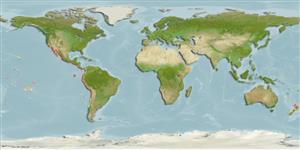>
Carangiformes (Jacks) >
Carangidae (Jacks and pompanos) > Trachinotinae
Etymology: Trachinotus: Greek, trachys, -eia, -ys = rough + Greek,noton = back (Ref. 45335).
More on author: Cuvier.
Environment: milieu / climate zone / profondeur / distribution range
Écologie
marin benthopélagique; profondeur 0 - 100 m (Ref. 122694). Subtropical; 35°N - 26°S, 121°W - 70°W
Eastern Pacific: Redondo Beach in southern California, USA to Chile, including the Galapagos Islands.
Taille / Poids / Âge
Maturité: Lm ? range ? - ? cm
Max length : 51.0 cm TL mâle / non sexé; (Ref. 2850); common length : 30.0 cm TL mâle / non sexé; (Ref. 55763)
Description synthétique
Clés d'identification | Morphologie | Morphométrie
Body deep (less so with age) and strongly compressed; mouth small; jaw teeth small, villiform, and only slightly hooked, disappearing with age; lower branch of first gill arch with 8 to 10 gill rakers; dorsal fin with 6 spines followed by another spine and 24 to 27 soft rays (VI+I, 24-27); upper third of body dark; belly white; flanks with golden highlights; no distinctive marks (Ref. 55763).
Adults are found in coastal waters, usually forming schools in shallow inshore sandy areas (Ref. 9283). They feed on mollusks, crustaceans, other invertebrates and small fishes (Ref. 9283). Excellent for human consumption. Minimum depth range based on estimate; to be replaced with a better reference.
Life cycle and mating behavior
Maturité | Reproduction | Frai | Œufs | Fécondité | Larves
Eschmeyer, W.N., E.S. Herald and H. Hammann, 1983. A field guide to Pacific coast fishes of North America. Boston (MA, USA): Houghton Mifflin Company. xii+336 p. (Ref. 2850)
Statut dans la liste rouge de l'IUCN (Ref. 130435: Version 2025-1)
Menace pour l'homme
Harmless
Utilisations par l'homme
Pêcheries: intérêt commercial mineur
Outils
Articles particuliers
Télécharger en XML
Sources Internet
Estimates based on models
Preferred temperature (Réf.
123201): 17.7 - 28.3, mean 23.2 °C (based on 70 cells).
Phylogenetic diversity index (Réf.
82804): PD
50 = 0.5000 [Uniqueness, from 0.5 = low to 2.0 = high].
Bayesian length-weight: a=0.01202 (0.00693 - 0.02085), b=2.88 (2.72 - 3.04), in cm total length, based on LWR estimates for this species & (Sub)family-body (Ref.
93245).
Niveau trophique (Réf.
69278): 3.7 ±0.55 se; based on food items.
Résilience (Réf.
120179): Milieu, temps minimum de doublement de population : 1,4 à 4,4 années (Preliminary K or Fecundity.).
Fishing Vulnerability (Ref.
59153): Moderate vulnerability (40 of 100).
🛈
